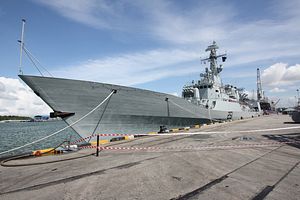So you want to steal a frigate. How would you go about doing it?
Ships are hard to steal in real life, but we do have a few examples. The crews of two Brazilian dreadnoughts mutinied in 1910, threatening to turn their guns on Rio De Janiero before giving up. In 1931 the Chilean Navy mutinied, with crews seizing ships and dockyard areas for about a week. Also in 1931, the Invergordon Mutiny briefly took control of four Royal Navy battleships. The Russian Navy, of course, suffered several mutinies in the early twentieth century.
Fictional thefts have enjoyed more success. In The Hunt for Red October, a small cadre of treasonous officers manages to steal a nuclear ballistic missile submarine. In Crimson Tide, the act is repeated under somewhat different circumstances. In Under Siege and again in Battleship, small groups with inside knowledge manage to steal the USS Missouri. In Star Trek III (oddly, probably the plot most similar to that of the Pakistani effort), a group of five officers orchestrates the theft of a Federation starship.
And so people have imagined stealing ships, and people have successfully stolen ships. With this in mind, how outlandish was the Al Qaeda plot to seize a Pakistani frigate and use it to attack U.S. warships? How hard is it to steal, and operate, a modern warship? After discussing the question with several naval professionals, the short answers seem to be: It depends, and it depends, but under any circumstances hijacking a warship would prove almost absurdly difficult.
How many people would you need? The answer depends on the condition of the ship, the sophistication of its systems, and the expertise of the personnel. Many functions are fairly basic, if the hijackers understand how to perform them. Engines that are in good condition can run with minimal maintenance for a time, and a handful of experienced sailors can steer a ship. A sufficiently prepared hijacking attempt might well manage to get a ship underway, depending on the level of base security. Slipping out of port (a complex task which depends on interaction with shore controllers, tugs, and other ships) would be more difficult.
What could and couldn’t you do with the ship? Again, the answer depends on how much access the hijackers have to ship systems, and on how familiar they are with the equipment. Sophisticated, well-trained hijackers could conceivably fire a weapon, but a successful attack requires not only firing the weapon but also identifying a target and vectoring the weapon to the target. Indeed, any hijackers able to get the ship moving might find that their best bet was simply to use the ship itself as a weapon, and ram an intended target. Unfortunately for the hijackers, experience suggests that even a frigate sized warship can cause only moderate damage to a larger vessel.
How much expertise would the thieves require? A successful hijacking would absolutely require a deep familiarity with the ship’s systems, as well as a good working knowledge of the particular ship’s condition. Even ships of the same class can develop quirks over time, and heavy use can affect different vessels in different ways, meaning that the crews need direct knowledge of the ship’s operations.
The theft of an entire warship would also be remarkably difficult to hide. Unless the entire crew were involved, the people left onshore would sound the alarm. The ship likely would not have access to its full suite of defensive systems, making it a sitting duck for sinking or recapture. Moreover, while the victimized navy might want its ship back intact, other navies are unlikely to have a sense of humor about a pirate-operated warship, and would probably attempt to sink or disable the ship at the earliest opportunity.
Modern navies, struggling with personnel costs, have tried their mightiest to reduce crew size over the last several decades. In practical terms, this means that there simply isn’t a lot of wasted space in a ship crew. Hijackers could ignore or jerry-rig some of the critical functions of the ship, but probably not for long, and not very effectively.
The only serious threat would involve either a full-scale mutiny on the part of the crew, or, more seriously, a conspiracy among the senior officers. Given the evidence of Al Qaeda penetration into Pakistan’s Navy, the latter seems quite unlikely, but hardly impossible.
































